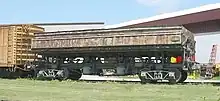Gondola (rail)
In North American railroad terminology, a gondola is an open-topped rail vehicle used for transporting loose bulk materials. Because of their low side walls, gondolas are also suitable for the carriage of such high-density cargos as steel plates or coils, or of bulky items such as prefabricated sections of rail track. Gondolas are distinct from hopper cars in that they do not have doors on their floor to empty cargo.

In Australia these wagons are called open wagons.
History
The first gondola cars in North America were developed in the 1830s, and used primarily to carry coal. Early gondolas were little more than flatcars with wooden sides added, and were typically small – 30 feet (9.14 m) or less in length, and 15 short tons (13.4 long tons; 13.6 t) or less in weight.[1] These cars were not widely used at first, as they could only be unloaded by workers shoveling out their cargo by hand, a slow and labor-intensive process. A solution for this problem was developed around the 1860s with the drop-bottom gondola, which had hatches installed in the floor which could be opened at a destination, with workers using shovels to direct cargo towards the hatches. This was an improvement over earlier gondolas, but still required manual unloading.[1]
.jpg.webp)
After the American Civil War, advances in technology, especially the development of steel, allowed new and larger gondola designs. New gondolas built with steel sides and frames (though wood was retained for flooring, since it was flexible and cheap to replace) were often built to lengths between 40 and 50 feet (12.19 and 15.24 m), and gradually increased in capacity from around 30 short tons (26.8 long tons; 27.2 t) to as much as 70 short tons (62.5 long tons; 63.5 t) by the early to mid 20th century.[1] Gondolas began to be built for specialized purposes; depending on their intended cargo, the side heights could range from just two feet (0.61 m) for bulk commodities like sand, to six feet (1.83 m) or more for loads such as pipes, ten feet (3.05 m), or more for light cargos like woodchips.[1] Covered gondolas were also developed for cargos that had to be protected from the elements, such as food and freshly made steel.[1] Starting in the 1950s and 1960s, high-sided gondolas were used for coal, thanks to stronger car construction and the invention of rotary car dumpers, which allowed these gondolas to be emptied automatically.[1]
Specialized car types
"Bathtub" gondolas

In the second half of the 20th century, coal haulage shifted from open hopper cars to high-sided gondolas. Using a gondola, the railroads are able to haul a larger amount of coal per car since gondolas do not include the equipment needed for unloading. However, since these cars do not have hatches for unloading the products shipped in them, railroads must use rotary car dumpers (mechanisms that hold a car against a short section of track as the car and track are slowly rotated upside down to empty the car) or other means to empty them. The term "bathtub" refers to the shape of the car.
The "Double Rotary" coal gondola is required in this consist. The "Double Rotary" referring to this car that has rotary couplers on both ends instead of one end.
Coil car
The coil car is a modified gondola designed specifically for carrying coils of metal.[2]
Track ballast gondolas

Track ballast gondolas carry ballast. These gondolas are side tipping.
See also
References
- Schafer, Mike (1999). Freight train cars. Mike McBride. Osceola, Wis.: MBI Pub. pp. 38–45. ISBN 0-7603-0612-5. OCLC 41002704.
- "What Is a Coil Car?". Union Pacific. October 5, 2021. Retrieved 2021-12-31.